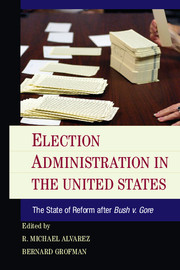Book contents
- Frontmatter
- Contents
- List of Contributors
- Foreword
- Acknowledgments
- Editors’ Introduction
- Part I Bush v. Gore in Perspective
- Part II What Has Changed since Bush v. Gore?
- 4 What Hath HAVA Wrought?
- 5 Voter Confidence in 2010
- 6 Early Voting after Bush v. Gore
- 7 Absentee Ballot Regimes
- Part III Remaining Challenges
- References
- Index
7 - Absentee Ballot Regimes
Easing Costs or Adding a Step?
Published online by Cambridge University Press: 05 October 2014
- Frontmatter
- Contents
- List of Contributors
- Foreword
- Acknowledgments
- Editors’ Introduction
- Part I Bush v. Gore in Perspective
- Part II What Has Changed since Bush v. Gore?
- 4 What Hath HAVA Wrought?
- 5 Voter Confidence in 2010
- 6 Early Voting after Bush v. Gore
- 7 Absentee Ballot Regimes
- Part III Remaining Challenges
- References
- Index
Summary
Introduction
There has been a revolution in voting in the United States in the past forty years. In 1972, voters in only two states had the option to request an absentee ballot without showing cause. In 2008, twenty-seven states allowed voters this opportunity. In 1972, voters in forty-five out of fifty states who were voting at a polling place did so on election day. In 2008, voters in thirty-one states could cast in-person votes on multiple days (notwithstanding the statute that designates the Tuesday after the first Monday in November as election day).
There are obvious political questions about the impact of these changes. Any time an electoral institution is changed we want to know if this will advantage one particular party or another, generally by making it harder or easier for partisans of that party to vote or by changing the incentives of parties to mobilize particular voters. In the case of these laws, the most obvious question to ask is whether they have affected turnout. If we make “election day” span two weeks rather than one day, we have significantly increased the opportunities people have to vote. Will otherwise nonvoters take advantage of those opportunities, or were they nonvoters by choice: they simply do not want to vote? Much of the existing research suggests that offering additional ways of voting has not raised turnout, but simply shifted the mechanism by which people vote (Stein, 1998; Stein and Garcia-Monet, 1997).
- Type
- Chapter
- Information
- Election Administration in the United StatesThe State of Reform after Bush v. Gore, pp. 144 - 154Publisher: Cambridge University PressPrint publication year: 2014
- 1
- Cited by



